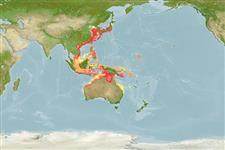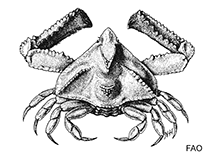Enoplolambrus validus (De Haan, 1837)
Strong elbow crab| Native range | All suitable habitat | Point map | Year 2050 |

|
| This map was computer-generated and has not yet been reviewed. |
| Enoplolambrus validus AquaMaps Data sources: GBIF OBIS |
Google image | No image available for this species;
drawing shows typical species in Parthenopidae.
Classification / Names Common names | Synonyms | CoL | ITIS | WoRMS
Malacostraca | Decapoda | Parthenopidae
Environment: milieu / climate zone / depth range / distribution range Ecology
Benthic; depth range 15 - 200 m (Ref. 125642). Subtropical; 42°N - 28°S, 103°E - 171°E
Distribution Countries | FAO areas | Ecosystems | Occurrences | Introductions
Central and Eastern Indo-Pacific: from Singapore to Samoa in the east, north to Japan and Korea and south to Moreton Bay, Australia. Subtropical to temperate climates.
Length at first maturity / Size / Weight / Age
Maturity: Lm ? range ? - ? cm Max length : 8.2 cm BL male/unsexed; (Ref. 83447); 7.7 cm BL (female)
Life cycle and mating behavior Maturity | Reproduction | Spawning | Eggs | Fecundity | Larvae
Main reference
References | Coordinator | Collaborators
Hong, S.Y., K.Y. Park, C.W. Park, C.H. Han, H.L. Suh, S.G. Yun, C.B. Song, S.G. Jo, H.S. Lim, Y.S. Kang, D.J. Kim, C.W. Ma, M.H. Son, H.K. Cha, K.B. Kim, S.D. Choi, K.Y. Park, C.W. Oh, D.N. Kim, H.S. Shon, J.N. Kim et al. 2006 Marine invertebrates in Korean coasts. Republic of Korea, Academy Publishing Company, Inc. 479 p. (Ref. 83447)
IUCN Red List Status
(Ref. 130435: Version 2025-1)
CITES status (Ref. 108899)
CMS (Ref. 116361)
Threat to humans
Human uses
Fisheries: commercial
| FishSource | Sea Around Us
Tools
More information
Diet composition
Food consumption
Predators
Max. ages / sizes
Length-weight rel.
Length-length rel.
Length-frequencies
Mass conversion
Abundance
Internet sources
BHL | BOLD Systems | CISTI | DiscoverLife | FAO(Publication : search) | Fishipedia | GenBank (genome, nucleotide) | GloBI | Gomexsi | Google Books | Google Scholar | Google | PubMed | Tree of Life | Wikipedia (Go, Search) | Zoological Record



